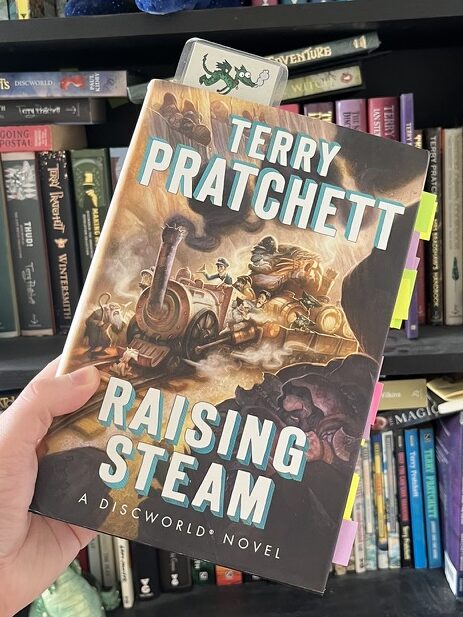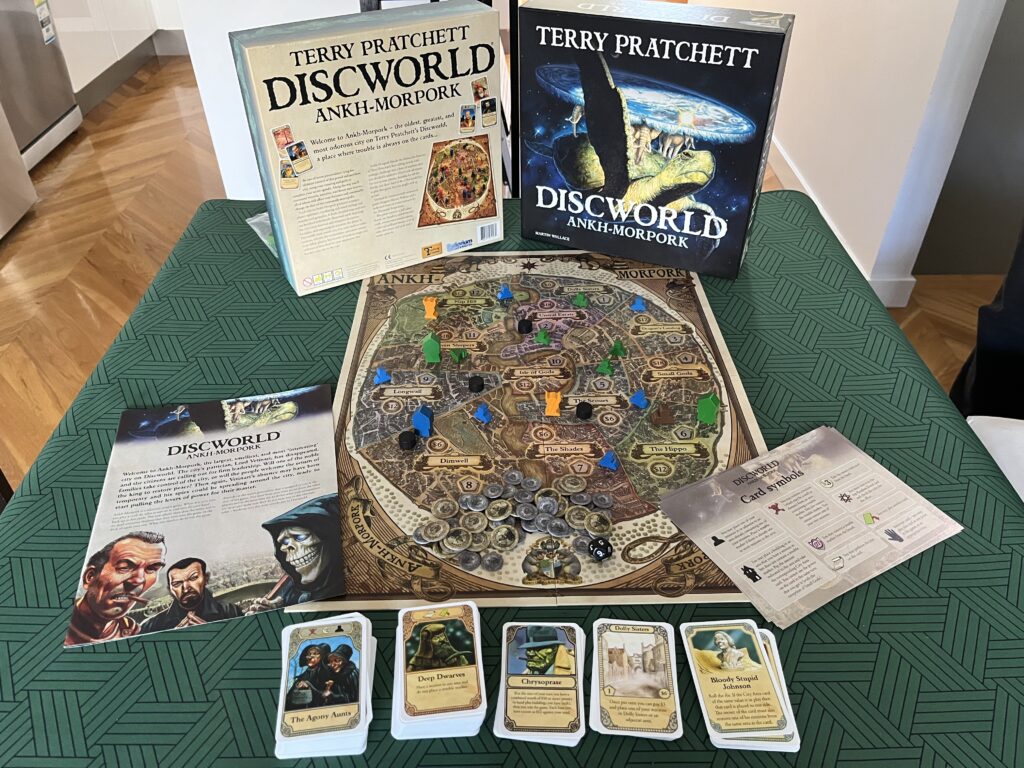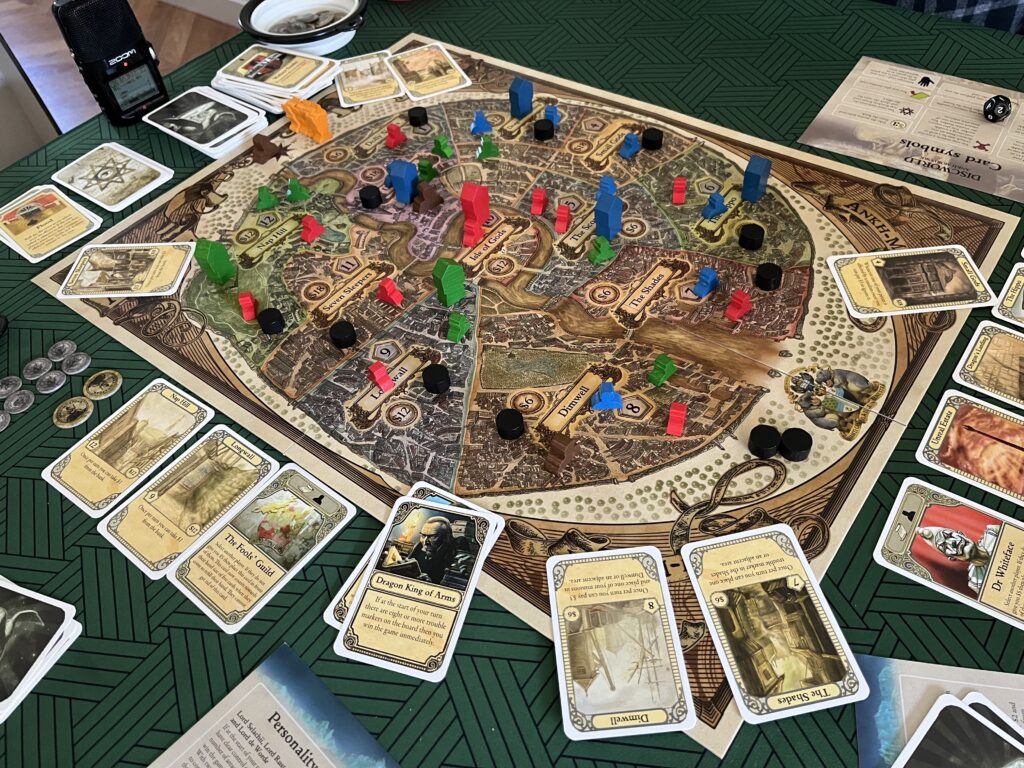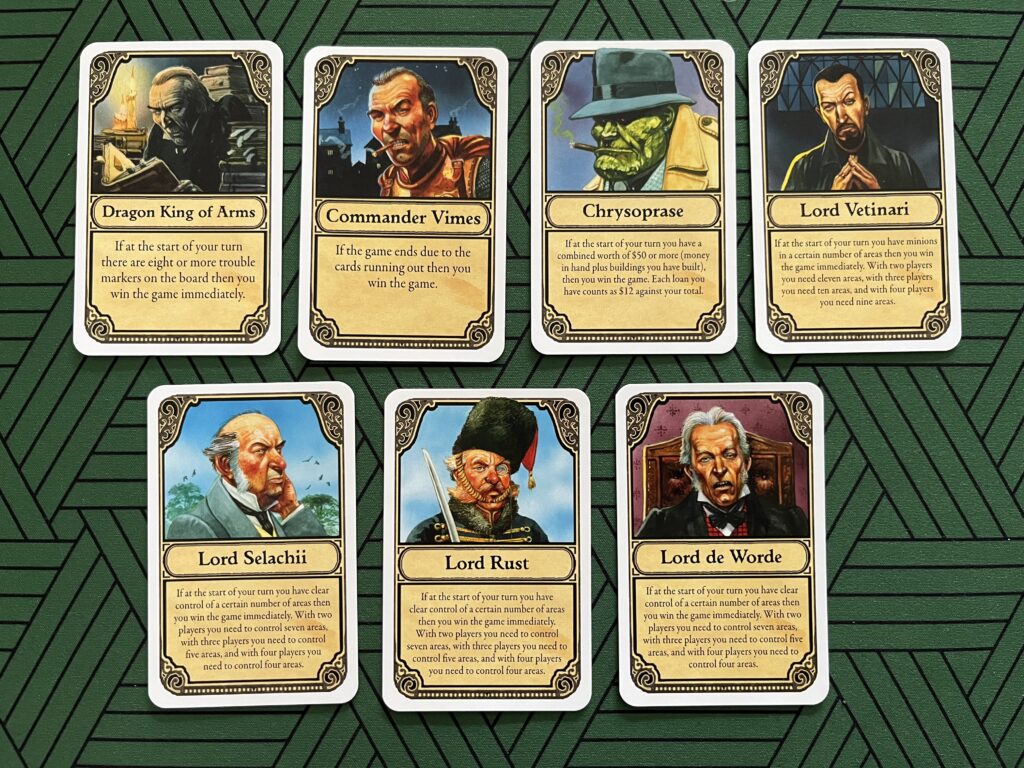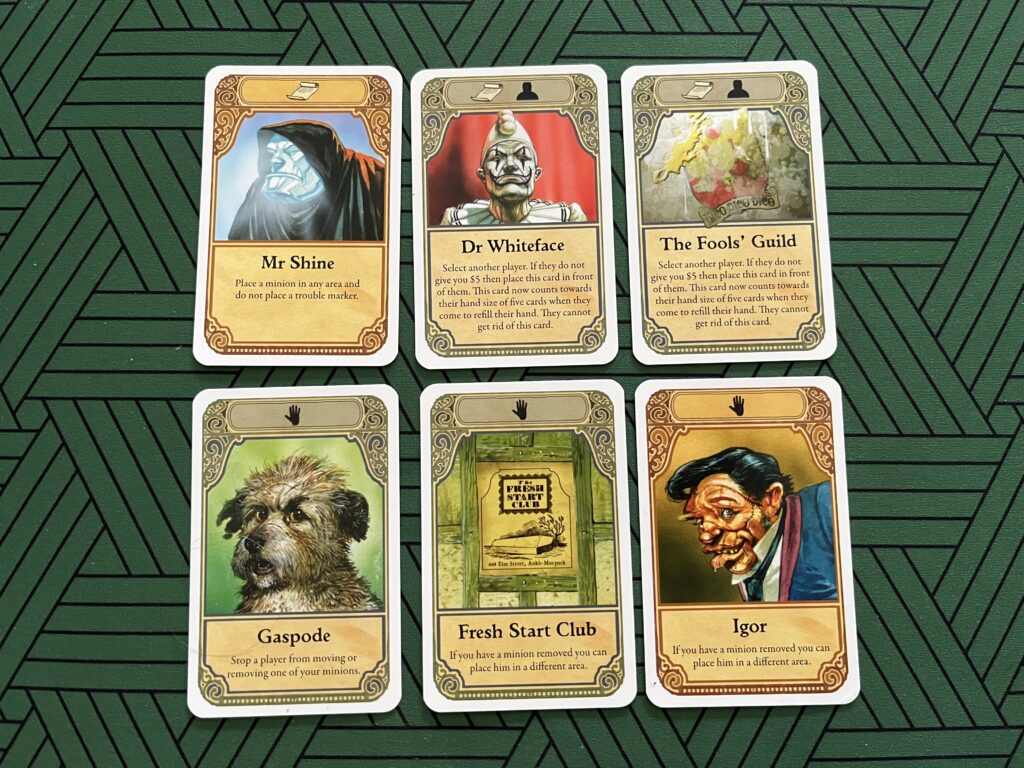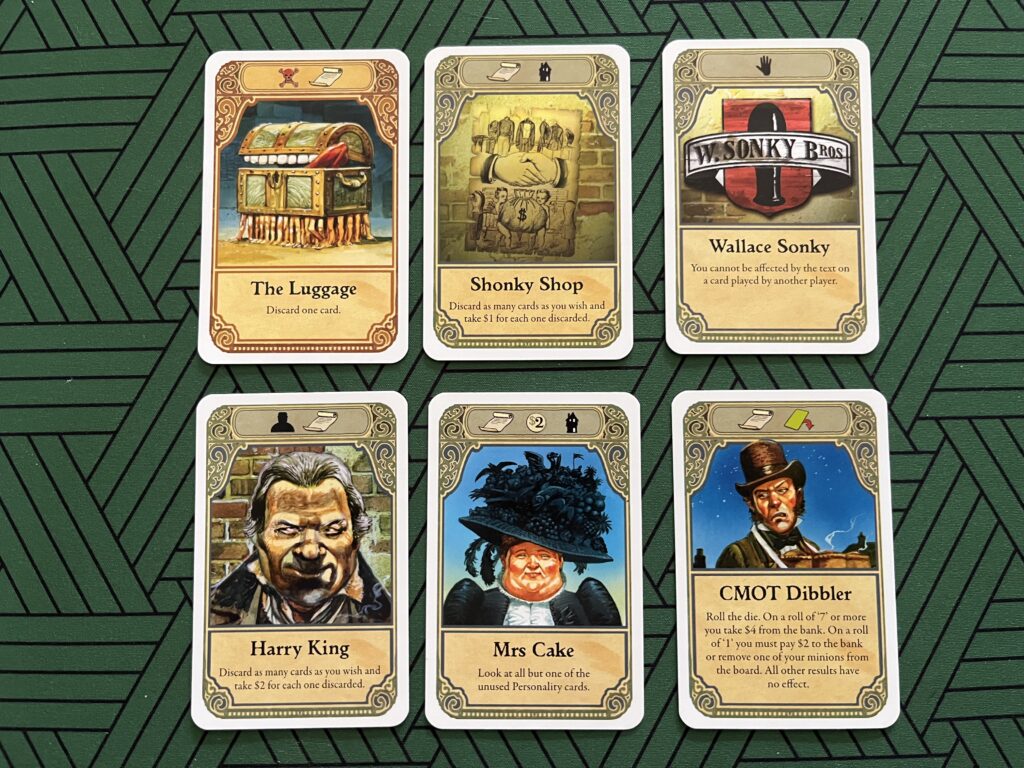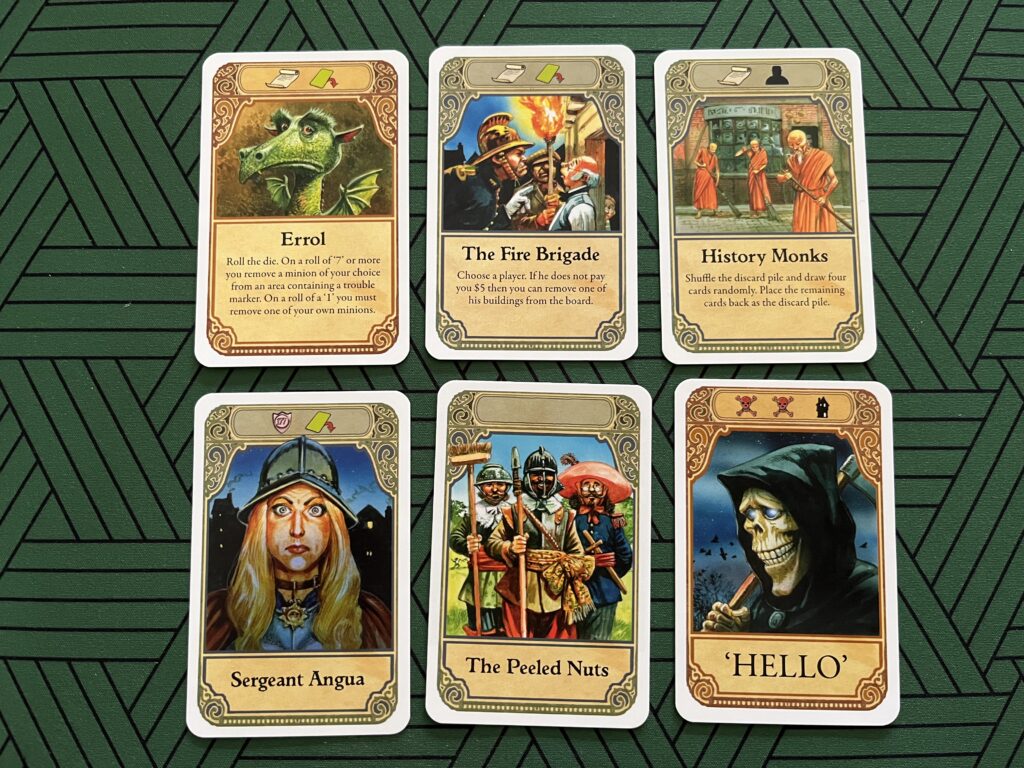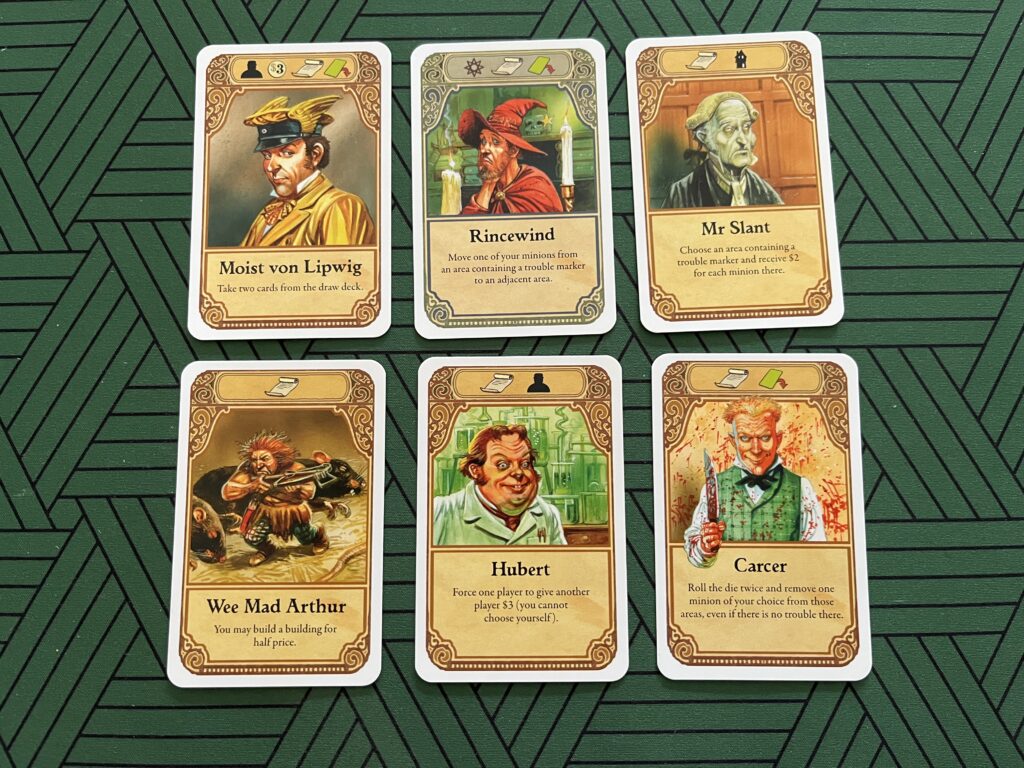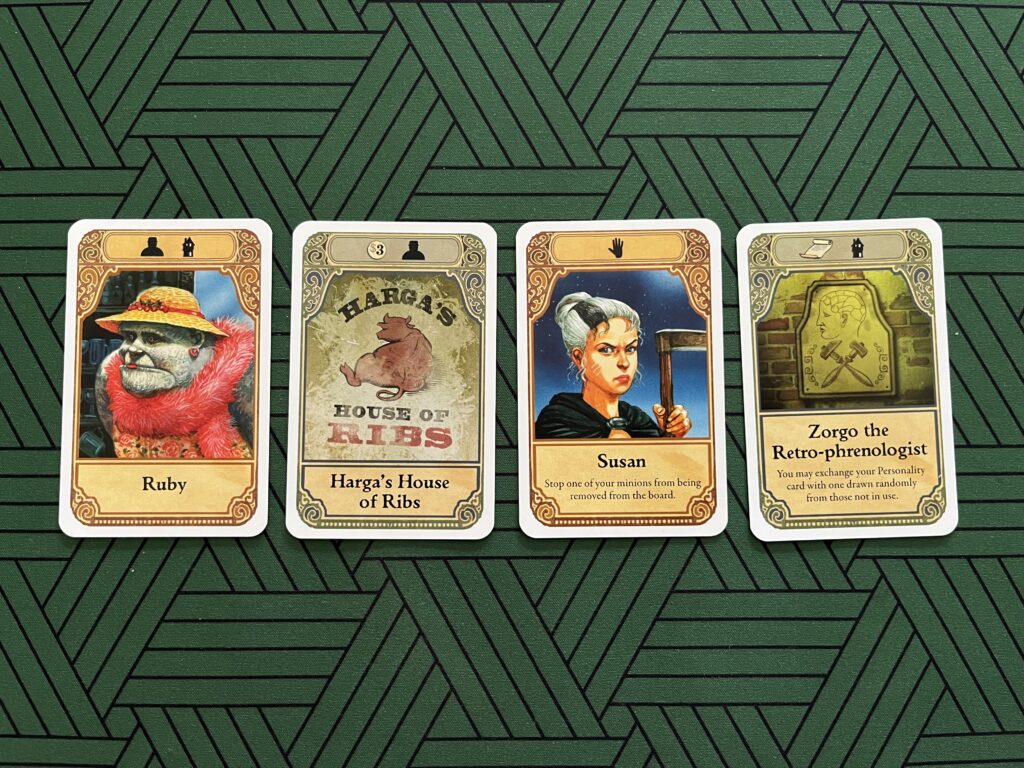#Pratchat1 Notes and Errata
Theses are the notes and errata for episode 1, “Boots Theory”, featuring guest Cal Wilson discussing the fifteenth Discworld novel, 1993’s Men at Arms.
- We did indeed have Cal back to discuss Sourcery – see #Pratchat3, “You’re a Wizzard, Rincewind”. Cal also returned for our fiftieth episode, “Salt Rat Arsenic Heat“, to discuss Nanny Ogg’s Cookbook. Tragically Cal passed away unexpectedly in 2023; but a person’s not dead while their name is still spoken. GNU Cal Wilson.
- For more on our decision to start with Men at Arms, see #Pratchat0, “And the Winner is…”, and also Liz’s post, “Let’s Start From the Very Beginning (but not actually)”.
- Men at Arms is the fifteenth Discworld novel, and the second to feature the Ankh-Morpork City Watch. Ben does now write these things down (and, indeed, has a very comprehensive spreadsheet).
- What Ben meant about the copyright on “Discworld” is that this is the first book in which “Discworld” appears on the imprint page as a registered trademark. Intellectual property (or IP) law is a complex topic, and can differ greatly from region to region, but to cover the basics:
- Copyright (denoted by ©) is the protection of original works from being copied or otherwise used without the creator’s permission. This mostly applies to literary, dramatic, musical or other artistic work (including visual art), often lasts for a fixed period (the creators’ life plus 70 years in Australia), and is automatically applied without a creator having to do anything. A creator can extend it to others, as Terry later did by assigning copyright to he and his wife Lyn, and then their company, Dunmanifestin Limited. Copyright doesn’t protect ideas, only the specific expression of ideas, which is where some of the complexity comes in.
- A trademark (denoted by ™️ or ®) is a “sign” that shows a product was made by a certain person or company. The sign can be almost anything: a word, a specific colour or style of packaging, a logo, a design, even a sound. It’s an old concept, similar to the “maker’s mark” used by artisans on silverware, jewellery, ceramics and so on, as often mentioned on Antique Roadshow. Anyone can start using the ™️ symbol, which suggests a common law trademark, but the ® denotes a registered trademark which is more easily enforceable by law. These are managed by government agencies (e.g. IP Australia). Also worthy of note: if you have a trademark, you have to actively be using it – and you must defend it if someone else starts using it, or you will likely lose it.
- It didn’t come up in this episode, but there are some complexities involved if a copyright belongs to a company and that company ceases to exist without its assets being transferred to another company or person. In the UK this can mean ownership of a work transfers half to the original creators, and half to the Crown, which has led to speculation that King Charles now owns half the rights to the Discworld videogames – though this has yet to be resolved… See our episode #Pratchat89, “An Awfully Teeny Weeny Adventure”, about the first Discworld game for more.
- You’ve probably heard of the Thames, but the Yarra is the common name for the river Birrarung or Biarrarung Marr, which flows through the heart of Melbourne, or Narrm. It runs for nearly 250 kilometres from the Yarra Ranges in inland Victoria to the ocean in Port Phillip Bay, though its course and nature has been changed extensively since European colonisation. It was previously nicknamed “the upside down river” due to the golden-brown muddy colouring it acquires by the time it flows through Melbourne. This is also the product of colonisation, as land clearing and mining have increased the erosion of surrounding fine clay into the water.
- The negative reviewer of Pratchett’s work to which Ben refers was Northern Irish poet and literary critic Tom Paulin, who appeared on BBC2’s Late Review television program and derided Pratchett, writing him off as a populist: “… selling thousands of copies – a complete amateur – doesn’t even write in chapters – hasn’t a clue.” This seems to have been in around 1993 or 1994; Pratchett proudly reproduced the quote in the front many of his books, with the earliest example Ben can find being in the 1995 Corgi paperback of Interesting Times.
- Terry Pratchett’s debut novel, The Carpet People, was first published in 1971, when Pratchett was 23 years old. However an earlier version of the story was serialised as some of his very first published fiction in the Bucks’ Free Press in 1965, when he was only 17! Most of the instalments of that version appear in the second collection of his early stories, Dragons at Crumbling Castle, published shortly after Pratchett’s death in 2015.
- While the Vimes Boots Theory is articulated in the way of Pratchett, the idea behind it is of course not new. We’d like to thank Jeanette Hall on Twitter, who shared a link to an earlier version of the Boots Theory! In 1914, Irish house painter and sign writer Robert Noonan wrote published the semi-autobiographical novel The Ragged-Trousered Philanthropists, “Being the story of twelve months in Hell, told by one of the damned, and written down by Robert Tressell.” (Tressell was the pen-name used by Noonan.) Based on his life working in Hastings between 1906 and 1910, the book contains a passage about the price of stockings and coal and how they are the means by which “the working classes are robbed.” We’ve included an excerpt below, but you can read the original text at the Union History website shared by Jeanette. You can also see the original manuscript! (This feels especially poignant because Ben’s own Great Great Grandfather was a painter in Belfast until his death in 1910 prompted the McKenzies to migrate to Australia.)
Although their incomes are the lowest, they are compelled to buy the most expensive articles – that is, the lowest-priced articles. Everybody knows that good clothes, boots or furniture are really the cheapest in the end, although they cost more money at first; but the working classes can seldom or never afford to buy good things; they have to buy cheap rubbish which is dear at any price.
Six weeks previously Owen bought a pair of second-hand boots for three shillings and they were now literally falling to pieces. Nora’s shoes were in much the same condition, but, as she said, it did not matter so much about hers because there was no need for her to go out if the weather were not fine.
The Ragged-Trousered Philanthropists, Robert Tressell, 1914
- Also of note: the Vimes Boots Theory influenced the work of UK equality and anti-poverty campaigner Jack Monroe, who in January 2022 created the Vimes Boots Poverty Index. The Index was intended to be a record of the prices of staple foods and other essentials over time, to demonstrate the disproportionate impact of rising prices on the poor. It was also specifically meant to show that government reports which only take inflation into account are inadequate, since they are not an accurate indicator of the way goods prices change. The Pratchett Estate – particularly Rhianna Pratchett – wholeheartedly endorsed this use of Vimes’ name. In the end, media and social media attention for the idea (using the hashtag #VimesBootsIndex) was enough to persuade the UK Office of National Statistics (ONS) to change how they calculated cost of living expenses, largely making the compilation of the Index unnecessary. You can read more about it on the L-Space wiki.
- Scooby-Doo is a children’s adventure show which began in 1969 with the Hanna-Barbera animated series Scooby-Doo, Where Are You! It centres on a group of mystery-solving teenagers: Fred Jones, Daphne Blake, Velma Dinkley, Shaggy Rogers and Shaggy’s dog, a Great Dane named Scooby-Doo. Sometimes calling themselves “Mystery Inc.”, the group travel America in a mini-van called the Mystery Machine investigating supposedly supernatural occurrences. Famously most of their adventures end by revealing that the ghost, monster or other weirdness was a hoax all along, perpetrated by an old man in a costume. The show was hugely influential – not least because it helped fill the gap left after more violent superhero cartoons of the 60s like Space Ghost and The Herculoids were cancelled following protests from parent groups. There have been numerous animated series and films, and even live-action films, since 1969, and more are still being made. The characters are not usually explicitly romantically linked; Cal references a reboot that had genius Velma and dorky hippie Shaggy dating, and this has happened at least a couple of times. They are shown to try dating in both the 2010 animated series Scooby-Doo: Mystery Incorporated and the 2011 live-action film Scooby-Doo: Curse of the Lake Monster (a sequel to the 2009 reboot of the previous live-action films from 2002 and 2004). For the record, in both versions they quickly realise they don’t have a spark and remain “just friends”.
- It is a 1986 horror novel by Stephen King in which a group of teenagers face a nameless evil creature, the titular “It”, which changes shape to evoke fear in its victims. It primarily appears in the shape of a clown named “Pennywise the Dancing Clown”. In a memorable sequence from early in the novel – replicated in both the 1990 TV mini-series adaptation and the first of the two-part film adaptations in 2017 – the Clown appears in the town sewer. In both versions Pennywise has primarily white-face makeup, not dissimilar to Paul Kidby’s version of Dr Whiteface. (“It” was portrayed by Tim Curry in 1990, and Bill Skarsgård in 2017.)
- Clowns in our world can and do copyright their face makeup, and the egg gallery is based on the “Clown and Character Registry”, where many clowns actually did register to have their makeup painted on a goose egg and displayed. In the UK, the tradition can be traced back to Stan Built in the 1930s, though most of his original eggs were damaged or destroyed. In 1988 (or 1984 according to some sources), Clown Bluey, Chairman of Clowns International at the time, resurrected the tradition. This mini documentary from 2017 features Debbie Smith, the Clown Egg Gallery artist from 2010 to 2023. Clowns International still seems to run the egg gallery, with their website including a form to order a pair of eggs (one for the gallery and one for you), now painted by current artist Julie Proctor. So we’re sorry again, clowns. (Thanks to Maia in Michigan, who put us onto some sources via Twitter which helped us update this entry!)
- Ben uses commedia dell’arte more-or-less correctly.
- 99% Invisible is a podcast all about design, hosted by Roman Mars. The episode about the invention of cellulose mentioned by Ben while discussing the Alchemist’s Guild is “The Post-Billiards Age” from May 2015. (This episode will get mentioned again in #Pratchat10, “We’re Gonna Need a Bigger Broomstick”.)
- There are indeed ghosts on the Discworld, appearing in several of the novels. We’ll be meeting some of them fairly soon, as one plays a major role in Wyrd Sisters. (See #Pratchat4, “Enter Three Wytches”.)
- The final Discworld book is actually The Shepherd’s Crown; I Shall Wear Midnight is the fourth-last, and the second-last to feature young witch Tiffany Aching. (We try to keep our spreadsheet handy in future episodes to avoid such basic mistakes.)
- “Shoot” is used for arrows, as the term predates guns by many centuries.
- CMOT Dibbler is pervasive once he arrives, but is not in The Colour of Magic. (See #Pratchat14, “City-State Lampoon’s Disc-Wide Vacation”.) In fact he first shows up when the Watch does, in Guards! Guards! (See #Pratchat7A, “The Curious Incident of the Dragon and the Night Watch”.)
- Not only are Lord Vetinari’s plans for the future unknown, but it has also never been revealed how he ascended to the position of Patrician in the first place. We do get a little of his backstory in Night Watch; see #Pratchat54, “The Land Before Vimes”.
- We are aware that despite being asked “which Guild would you join”, we decided we would be wizards, witches or members of the Watch, none of which have an official guild – at least at the time of Men at Arms. See #Pratchat40, “The King and the Hole of the King”, for the creation of at least a temporary guild of Watchmen in The Fifth Elephant.

